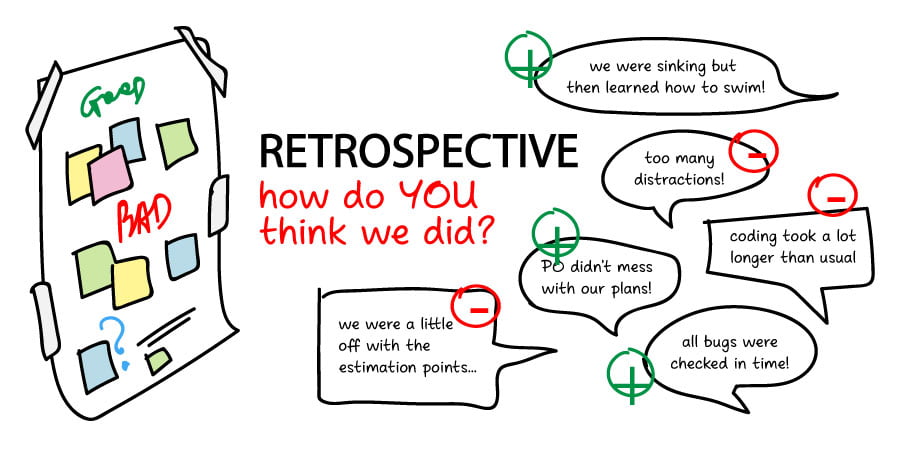
Sprint Retrospective is a short meeting for project teams to reflect on the most recent stage of their project, analyze their processes, and identify things they can do better moving forward. Regular agile retrospective meetings support constant learning and improvement over the life cycle of the project.
Start Stop and Continue Sprint Retrospective
Glad-Sad-Mad Sprint Retrospective
Starfish Sprint Retrospective
Sailboat Sprint Retrospective
Liked Learned Lacked Longed For (4Ls) Retrospective
Start, Stop and Continue Sprint Retrospective
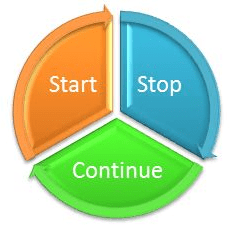
Start Stop and Continue is a great format to focus on the things that are working (continue), things that are not working (stop), and things that the team should start doing (start).
More Details: Click Here
Glad-Sad-Mad Sprint Retrospective
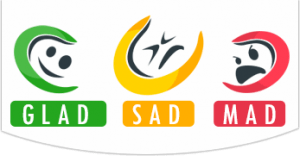
Mad Sad and Glad retrospective encourages team members to think about their emotions, feelings after the last sprint. It is a simple way to learn while being easy to explain and elicit ideas. Both Mad and Sad are obviously negative but each can attract quite different issues from a team. Similarly Glad positive and attract what made them feel happy or proud. This exercise will help build a positive team dynamic and provide an opportunity to reflect on issues and opportunities from a different perspective.
More Details: Click Here
Starfish Sprint Retrospective
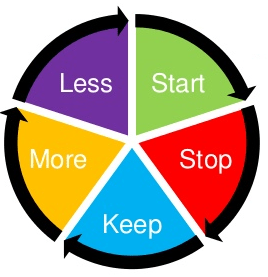
The Starfish Method for Sprint Retrospectives is an easy way to: achieve focus, give a voice to every member, and foster the thinking around practices and the value the team gets from it. It helps teams reflect on varying degrees of actions and activities rather than simply the traditional what went well or what did not go well.
More Details: Click Here
Sailboat Sprint Retrospective
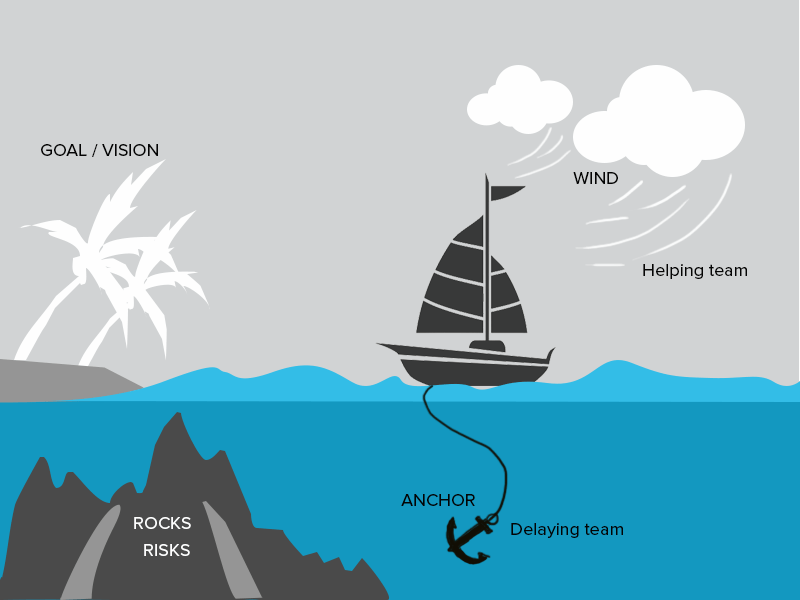
The Sailboat or Speedboat Method for Sprint Retrospectives is an easy way to: adopt, reflect and map the team’s way forward easily, in a fun, tactile and visual way. It helps the team to reflect on what’s going well and what could be better, analyze their sails and anchors, and identify opportunities for improvement or change.
More Details: Click Here
Liked Learned Lacked Longed For (4Ls) Retrospective
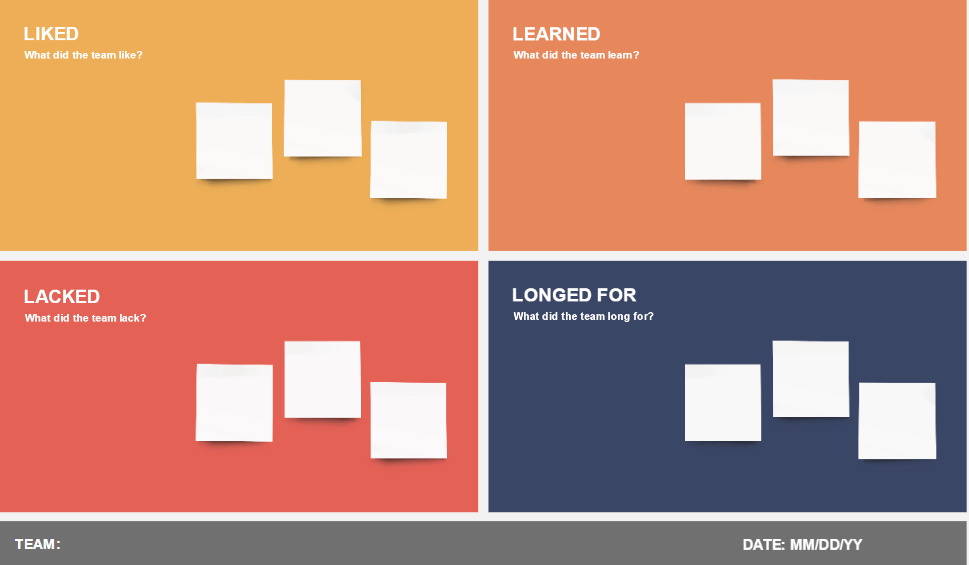
4Ls stands for Liked, Learned, Lacked, & Longed For. The 4Ls technique is a brainstorming technique for collecting feedback on a recently completed project or piece of work. This retrospective highlights the positive (liked & learned) as well as the negative (lacked & longed for). The team has to think mostly from a factual (what happened) perspective, rather than an emotional perspective.
More Details: Click Here
Sprint Retrospective Tools for Distributed Agile Teams
Performing a retrospective at the end of a sprint is an important concept within Scrum. Global delivery model (Offsite & Onsite collaboration) distributed agile teams are more common. Facilitating such sessions with team members across the globe is very difficult. This post will bring 6 scrum retrospective tools you can use when you run retrospectives for distributed teams. Please note I am in no way affiliated with any of these tools/websites and receive no compensation for writing this article.
Parabol
Parabol is an open-source online retrospective tool, planning poker estimation tool, and online standup tool for remote teams. Parabol helps teams reflect on their work, discuss, and make progress in less time.
Parabol comes with a powerful suite of facilitator tools, including timers, a “ready button” and integrations that remove friction. It describes itself as an “agile meeting co-pilot”.
Parabol helps save Scrum Masters and facilitators meeting prep time, with a library of 40+ pre-made retrospective activities.
In a recent study by Parabol, they found that 92% of users said the tool made their retrospective meetings more efficient.
Parabol’s key features:
- Anonymous reflections for open and honest conversations.
- Clear meeting structures so you can keep meetings on track.
- Multiplayer grouping with advanced search for big retros.
- 200+ built-in icebreakers to connect as a team at the start of each meeting.
- Facilitator tools include a next button, ready button, and timer.
- Automatic meeting summaries are distributed by email so nobody has to take notes.
- Customizable retrospective templates.
- Integrations with Atlassian Jira, GitHub, Slack, and Mattermost. Integrations with Microsoft Teams, Azure DevOps, and GitLab are in progress.
Parabol is free for up to 2 teams per company. The paid Pro plan is $6 per active user. The Enterprise plan features SSO, advanced security, and on-prem hosting if needed.
Web sites: https://parabol.co
Chpokify
Chpokify is a Planning Poker, Retrospective & Kanban online solution for agile teams. It simplifies the process of gathering feedback from team members and makes it easier to collaborate and communicate.
Planning poker online tool helps effectively set story points and sprint goals during sprint planning. Key benefits of the Planning Poker tool are
- Saves time of sprint estimation by speeding up preparation using automating manual work, seamless JIRA integration, import/export functionality, and auto-summary.
- Reduces estimation time by allowing multiple teams’ sessions, smart voting management, and auto-reveal of all cards.
- Boost estimate precision by making less optimistic and more realistic estimates with the planning poker estimation technique.
- Maintaining the team’s velocity at the highest rate, and identifying possible risks at an early stage.
Chpokify Scrum Project Management differentiates itself from other competitors by having a user-friendly design and effective team-based workflow that brings the final product to life. It also provides project reports and team performance analytics.
Chpokify Kanban board simplifies sprint progress by just dragging cards between columns.
Chpokify Retrospective solution identifies shortcomings within the team, and processes, and helps the team to plan ways to increase quality and effectiveness. The retrospective tool has two modes
- Guided mode – Follow the flow and you will go through all the steps of the retro by navigation bar.
- Advanced mode – When you are experienced you can build your own retro process with a handy sidebar on the right.
It also offers free retrospective templates like Glad – Mad – Sad, Start – Stop – Continue, and What – Went – Well.
The features which I like the most are the team management in Scrum poker, timeline view in kanban board, or incognito mode during a retrospective. Chpokify is driven by the idea of a future where people have the choice to work collaboratively and efficiently working remotely or from the office.
Web sites: https://chpokify.com/
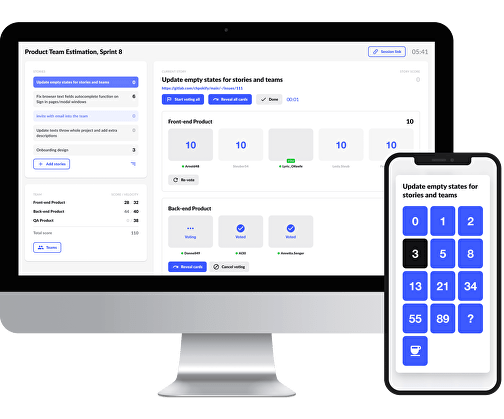
Fun Retro
Fun Retro is an online open-source tool that provides a retrospective board. Its basic template can be customized by adding additional columns or changing their name of them. You can have multiple people involved by simply sharing the website URL. You manage the retrospectives topics and actions using simple colored cards. A “like” button on each card allows the participant to express their opinion on its content. You can also export the retrospective items and their votes in PDF, CSV, or copy to clipboard format.
Web sites: http://funretro.github.io/distributed/
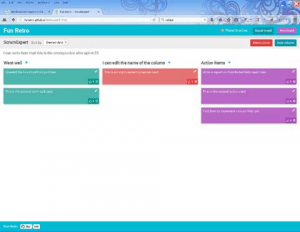
IdeaBoardz
IdeaBoardz is a free online tool for brainstorming, storyboarding, and retrospectives. It allows teams to collectively gather inputs, reflect and retrospect. It is especially useful for distributed teams. For Scrum retrospectives, you can create two types of boards: standard or starfish. More board options are available (pros & cons, to-dos) that could be also useful. You can edit the titles of the sections of your board. The interface seems very intuitive, but sometimes I ended up in some situations where I didn’t know how to exit gracefully, for instance when I focused on one sticky note to vote or update it. The updating process works however fine, so you will not lose your updates if you have to take an “emergency exit” from your board. The board has some filtering and ordering features if there is too much information on it. You can export the information of your board to a pdf or Excel.
Web site: http://www.ideaboardz.com/
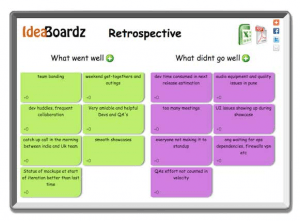
goReflect
goReflect is a free online retrospective tool that is based on the starfish model for retrospectives using Start, More, Continue, Less and Stop.
Features:
- Stream (preview): A natural evolution of the retrospective that enables you to share your contributions in a familiar way.
- Vote on Cards: Like or dislike any card on the retrospective board.
- Multiple Board Types: Choose from a variety of board types or create your own custom board.
- Card Archive: Each retrospective board is perpetual, so once a retrospective item has been discussed, it can be removed from the board by sending it to the archive.
- Dashboard: Analytics offers an interesting view of the retrospective and builds a fun and competitive spirit across the team.
- Comments: Add comments to any card to share your feedback with the team.
- Notifications: Optionally receive notifications for new cards and or comments to keep up with board activity.
- Real-time Board: See others’ contributions as they’re added to the board in real-time.
- Export to Excel: Export the retrospective board to Excel to create your own analytics.
Web site: https://www.goreflect.com/
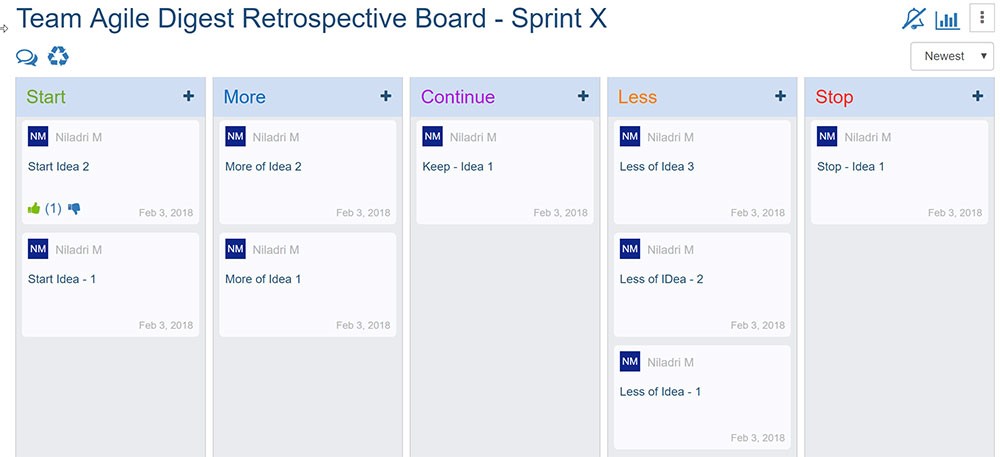
Sprint Board
Sprint Board is an online retrospective tool for Agile developers, providing distributed teams with the tools they need to coordinate, discuss and collaborate in real-time. Cards are divided into different colored stacks in a set of three, four, or five columns, depending on the type of retrospective you want to run. With support for card merging, Slack invites, card masking, and team access control, Sprint Boards provides scrum masters with the tools they need to make their retrospectives effortless.
Features:
- Merge Cards: Different members of your team may add their own cards referring to the same task or issue. When this happens, you can drag the duplicate over the original card to merge them together.
- Highlight Cards: Quickly draw attention to a card by highlighting it to others. We’ll flash the card to other participants and even scroll it into view if needed.
- Card Masking: Avoid peer-to-peer influence by masking each others’ cards until the end of your retrospective. With this option enabled, participants will only see the content of their own cards.
- Copy to Clipboard: Forget highlighting each part of a card to copy its contents. Just right-click on a card and choose the option and we’ll automatically format the card contents for you.
- Lock Boards: When you’ve finished your retrospective, you can lock your board to prevent further changes. This is especially useful when you’re ready to start reviewing your teams’ submissions.
- Team Management: Allow members of your team to create boards on your behalf, or restrict board access to only registered members of your team.
- Slack Integration: Send invites to your team on Slack, in any public or private channel you have access to.
- Trello and Jira: You can integrate with these third-party tools to export your most important cards – like your Action Items – to a board on Trello, or a project on Jira.
- Excel and CSV: Export your cards and their votes to a Microsoft Excel file, Open Document spreadsheet or CSV file.
Web site: https://sprintboards.io/
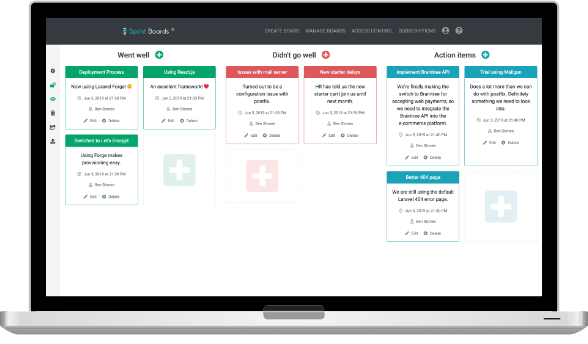
Scrum Toolkit
Scrum Toolkit is a free online tool for a distributed retrospective. Only one person of the Scrum team is required to register at Scrum Toolkit. The team members can join a retrospective session without registering. Retrospectives are called “games” in the Scrum Toolkit. You can choose between two models of retrospectives: the “What went well? & What can be improved?” or “Start doing, Continue doing, Stop doing”. After the board is created, you simply share its specific URL with the other participants. Each participant can add items that are then grouped in “buckets”. Participants can then upvote the three items which are most important to address in the next sprint. The ScrumMaster can monitor if everybody voted.
- Register: The scrum master registers at Scrum Toolkit. Register via the top navigation “sign-in / Join”. Please fill in your email address and password followed by “create account”.
- Start a new retrospective game: Create a new game from the “My overview” page. When creating a new given then you can give the game a name.
- Share & Join to start: The scrum master can share the link with all the team members. Team members can join without creating an account. Each team member needs to join using a unique name.
- Add items that went well and what can be improved: All the team members add items that went well and items that can be improved. At this stage all the items are private.
- Discuss & Group items: During the grouping of items are all items visible to all team members. The team discusses the items and when applicable can items are grouped together in buckets.
- Vote for the most important item to resolve: The last step is for each team member for the top 3 items which need to be improved in the next sprint. This helps the team to set priorities.
Web site: https://www.scrum-toolkit.com/
DISCLAIMER: This post contains sponsored content. Users are advised to check the service for their satisfaction before availing of the service. Tech Agilist is not responsible for any direct or indirect loss.
